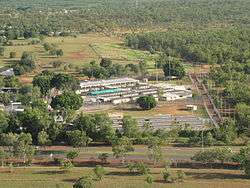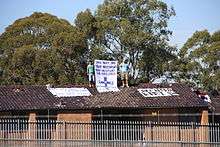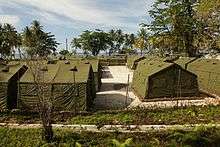Australian immigration detention facilities
Australian immigration detention facilities comprise a number of different facilities throughout Australia (including one on the Australian territory of Christmas Island).[1] They are currently used to detain people who are under Australia's policy of mandatory immigration detention. Asylum seekers detected in boats in Australian waters have been detained in facilities on the offshore islands of Nauru and Manus Island, previously under the now defunct Pacific Solution and (since 2013 and as of March 2019) under Operation Sovereign Borders.
The facilities' existence has been condemned on human rights grounds and have even been likened to concentration camps by some critics.[2][3]
Background
The Migration Act 1958 allowed discretionary detention of unauthorised arrivals until 1992. Since the 1990s when the Keating Government created a policy of mandatory detention of unauthorised arrivals, with non-citizens arriving by boat without a valid visa being detained until they were either granted a visa, or deported.[4]
Towards the end of the 1990s, a large increase in the number of unauthorised arrivals exceeded the capacity of the existing Immigration Reception and Processing Centres at Port Hedland and Curtin.[5]
Facilities
Immigration Detention Centres (IDCs)


Immigration detention centres detain people who have overstayed their visa, breached their visa conditions and had their visa cancelled or have been refused entry at Australia's entry ports.[6] This includes irregular maritime arrivals claiming asylum without passports, identity papers or valid entry visas. Under the Migration Act 1958, people arriving in this manner are classed as unlawful non-citizens and are currently subject to mandatory detention. However, in 1954 the Australian government ratified the United Nations Convention Relating to the Status of Refugees. Under Article 31 of the convention, the Australian government is legally obligated to grant anyone fleeing persecution and seeking asylum the right to enter the country by whatever means possible. Furthermore, the Article states that signatory countries are not to impose penalties on or indefinitely restrict the freedom of movement of those seeking asylum.[7]
Australia's Migration Act 1958 requires people who are not Australian citizens and who are unlawfully in Australia to be detained. Unless they are given legal permission to remain in Australia by being granted a visa, unlawful non-citizens must be removed from Australia as soon as reasonably practicable. The Australian government claims that immigration detention is not used to punish people. Instead, they claim it is an administrative function whereby people who do not have a valid visa are detained while their claims to stay are considered or their removal is facilitated.[8]
There are, or were, centres located at:
- Maribyrnong, established at Melbourne in 1966.
- Villawood, established at Sydney in 1976.
- Perth, established in 1981.
- Christmas Island, established 2001.
- Northern, established at Darwin in 2001.
- Baxter, near Port Augusta, SA, established 2002, closed 2007.
- Wickham Point, established at Darwin in 2011.
- Curtin, near Derby, WA, reopened in 2010.
- Scherger, near Weipa, Queensland, opened 2010, closed 2014.[9]
- Yongah Hill, near Northam, WA, established in 2012.
Immigration Residential Housing Centres (IRHC)
Immigration residential housing provides an option for accommodating people in independent family-style housing in a community setting while still formally being detained. This type of facility is one of several types of alternative residential accommodation for detained people, subject to them meeting eligibility criteria.[10]
- Perth
- Sydney
- Port Augusta
Immigration Transit Accommodation Centres (ITAC)
The Brisbane Immigration Transit Accommodation opened in November 2007 and the Melbourne Immigration Transit Accommodation opened in June 2008. Further immigration transit accommodation opened in Adelaide in 2011. ITCs are for short-term, low-risk detainees,[11] however the Melbourne facility was extended with a high-security compound in 2018.[12]
- Brisbane
- Melbourne
- Adelaide
Alternative Places of Detention (APOD)
Alternative Places of Detention (APOD) can accommodate any person who is in immigration detention. APOD may range from hospital accommodation in cases of necessary medical treatment, schools for the purpose of facilitating education to school-aged minors, rented accommodation in the community (hotel rooms, apartments), or accommodation in the community made available through arrangements with other government departments.[13]
- Darwin
- Inverbrackie
- Leonora
- Christmas Island

Pacific Solution facilities
Since the implementation of the Pacific Solution Australia also funded immigration detention centres on:
- Manus Regional Processing Centre, Papua New Guinea closed in February 2008, re-opened on 22 November 2012 (re-closed on 23 November 2017).[14]
- Nauru Regional Processing Centre closed in February 2008, re-opened in 2012.[15]
Services to immigration centres
Most facilities were operated by Australasian Correctional Management (a subsidiary of G4S) under contract from the Department of Immigration until 2003, when ACM exited the market. Between 2003 and 2009, G4S was appointed as the contractor to manage a large number of facilities. Its contract was not renewed and in 2009 Serco Australia was awarded a five-year contract.
Manus Regional Processing Centre was operated by the International Organization for Migration, then by G4S, then by Broadspectrum (formerly Transfield) with security sub-contracted to Wilson Security.
Nauru Regional Processing Centre was operated by Broadspectrum and Wilson Security, and then later by Canstruct International (with a $591 million contract) and finally by a Nauruan Government Commercial Entity.
The 3 new immigration detention facilities in Lorengau on Manus Island have security and some services provided by Paladin Group under a contract worth more than $423 million.
Christmas Island Immigration Detention Centre was once operated by G4S[16] but is now operated by Serco as of April 2019.[17]
Controversy
The facilities have been a source of much controversy during their time of operation. There have been a number of riots and escapes,[18] as well as accusations of human rights abuses from organisations such as refugee advocates, Amnesty International, the Australian Human Rights and Equal Opportunity Commission, Human Rights Watch, and the United Nations. Journalists are forbidden from entering the detention centres.[19]
In January 2014, the Australian Labor Party and the Australian Greens accused the government of a cover-up over a violent clash on 18 October 2013 at the Manus Island facility between the Papua New Guinea army and the Papua New Guinea police mobile squad hired for the facility's security, leading to Australian expatriate staff being evacuated, while local staff and asylum seekers remained.[20] On 5 May 2014, it was reported that several Salvation Army staffers had alleged that refugees were regularly subjected to beatings, racial slurs, and sexual assaults within the facility.[21]
In March 2002, Irene Khan, the Secretary General of Amnesty International, said:
It is obvious that the prolonged periods of detention, characterised by frustration and insecurity, are doing further damage to individuals who have fled grave human rights abuses. The detention policy has failed as a deterrent and succeeded only as punishment.
How much longer will children and their families be punished for seeking safety from persecution?[22]
Former Prime Minister John Howard and successive immigration ministers maintained that their actions were justified in the interests of protecting Australia's borders and ensuring that immigration law was enforced.
Refugee "Swap" with the US
In 2016 the Australian government announced an intention to exchange some proven refugees from either Nauru and/or Manus Island for certain displaced people presently in Central America as part of an agreement with the Obama administration of the United States.
In early 2017 Prime Minister Malcolm Turnbull announced that he was confident the agreement would proceed, despite the change of President to Donald Trump. However, latest information appears to cast doubt on the willingness of the US government to honour any such agreement, especially in light of Trump's executive order suspending entry to the US from several countries.[23]
On 2 February 2017 Australian news outlets, quoting the Washington Post, reported that a telephone conversation between Trump and Turnbull had been acrimonious in relation to the "swap", and that Trump had terminated the call ahead of time.[24] Trump has expressed admiration over the detention facilities, opining that the US should do the same.[25]
On 4 February 2019 the remaining 4 children who had been detained on Nauru were sent to the U.S.[26]
In May 2019, it was revealed that some of the U.S. detainees sent to Australia in the "swap", were Rwandan men, former members of the Army for the Liberation of Rwanda, who had been accused of mass-murdering tourists in 1999. They had been held in U.S. immigration detention for over 15 years, but were on the verge of being released into the U.S. after a court ruled that their confessions had been obtained by torture. In November 2018 the men were secretly brought to Australia. The Turnbull Government knew about the allegations against the men when they agreed to accept them. The Australian and U.S. Governments initially refused to comment on the matter, but later Prime Minister Scott Morrison said that the men had been assessed by security agencies.[27][28]
The former New Zealand foreign affairs minister Gerry Brownlee described Australia's behaviour as "incredibly insensitive" and said that New Zealand would have "appreciated a heads up" that Australia was about to resettle men accused of brutally murdering two New Zealanders [among others].[29]
Suicide and self-harm attempts increase on Manus
After the Australian Liberal Party were (unexpectedly, according to polls) re-elected 2019 Australian federal election, reports of despair and attempted self-harm and suicide were reported from Manus. The men had hoped with Labor in government, the New Zealand offer would be accepted and they would at last be resettled. By 4 June there had been at least 26 attempts at suicide or self-harm by men in the Lorengau camps and Port Moresby (in the hospital and accommodation for sick asylum seekers).[30] The PNG paramilitary police squad was deployed around one of the camps in an attempt to deter suicide and self-harm attempts. Lorengau general hospital has been handling many of the self-harm and suicide cases, despite the Australian government contract with Pacific International Health (PIH), because of the seriousness of the cases. The police commander commented that they were doing all they could, but severe mental illness arose because of the effect of long-term detention on the men.[31]
References
- "=Australia". Immi.gov.au. Archived from the original on 5 November 2013. Retrieved 1 December 2013.
- Charles, Stephen (4 May 2016). "Our detention centres are concentration camps and must be closed". Australia – via The Sydney Morning Herald.
- "No Pacific paradise: Trump's call to PM shines light on detention camps". NBC News.
- Archived 29 July 2009 at the Wayback Machine
- "Report" (PDF). Australia: Commonwealth of Australia. 2008. Archived from the original (PDF) on 10 August 2008. Retrieved 10 August 2008.
- "Fact Sheet 82 - Immigration Detention". Immi.gov.au. Archived from the original on 7 May 2012. Retrieved 1 December 2013.
- "The Refugee Convention - Article 31: Refugees unlawfully in the country of refuge". Archived from the original on 20 March 2014.
- "About immigration detention". Immi.gov.au. Archived from the original on 28 May 2013. Retrieved 1 December 2013.
- Ireland, Judith (14 January 2014). "Scott Morrison announces closure of four immigration detention centres". The Sydney Morning Herald. AAP. Retrieved 30 July 2015.
- "About the facilities". Immi.gov.au. Archived from the original on 22 May 2009. Retrieved 1 December 2013.
- "About the facilities". Immi.gov.au. Archived from the original on 15 March 2009. Retrieved 1 December 2013.
- Hall, Bianca (10 January 2019). "'Brutality': protests and violence at Melbourne detention centre". The Age. Retrieved 11 September 2019.
- Ujjal, Thakur (18 October 2019). "Emigrate to Australia ⋆ Information (Vetted)". Lets Go Global Australia Immigration. Retrieved 20 December 2019.
- "First Asylum Seekers Sent to Manus Island". Theaustralian.com.au. Retrieved 1 December 2013.
- "Troops ready to reopen detention centres on Nauru and Manus Island". Theaustralian.com.au. Retrieved 1 December 2013.
- "Immigration Detention Services". G4S. 2008. Archived from the original on 26 May 2010. Retrieved 7 October 2010.
- "Government sends 140 Serco staff to Christmas Island despite no refugees being there". The Sydney Morning Herald. 4 April 2019.
- "ASIA-PACIFIC | Australia's asylum policy". BBC News. 31 August 2001. Retrieved 1 December 2013.
- "Lack of media access into detention centres is shaping the asylum seeker conversation in Australia". www.ibtimes.com.au.
- "Cover-up of violent PNG police-army clash on Manus". The Sydney Morning Herald. Retrieved 5 January 2014.
- "Ex-Manus Island workers report beatings, rapes of asylum seekers". The Sydney Morning Herald. 6 May 2014. Retrieved 6 May 2014.
- "Secretary General Irene Khan to respond to Woomera Incidents" (Press release). Amnesty International. 8 March 2002. Archived from the original on 13 January 2006. Retrieved 13 January 2007.
- "Australia will be expected to 'reciprocate' eventually". NewsComAu. 31 January 2017. Retrieved 20 December 2019.
- "Trump 'blasts, hangs up on Turnbull'". The Daily Telegraph. 1 February 2017. Retrieved 20 December 2019.
- "Trump urged Mexican president to end his public defiance on border wa…". 3 August 2017. Archived from the original on 3 August 2017.
- Kennedy, Merrit (5 February 2019). "Last 4 Children Detained on Nauru Are Heading to the U.S." NPR.
- Josh Gerstein (15 May 2019). "'That's Just Insane': Australia's Secret Deal to Take in Rwandan Guerrillas From the U.S." POLITICO. Retrieved 24 May 2019.
- Andrew Greene (17 May 2019). "Rwandans accused of 1999 tourist murders in Uganda secretly brought to Australia in deal with United States". Australian Broadcasting Corporation. Retrieved 24 May 2019.
- Ben Fordham (16 May 2019). "'Incredibly insensitive': NZ outrage as accused Rwandan murderers resettled in Australia". 2GB. Retrieved 24 May 2019.
- Boochani, Behrouz (3 June 2019). "How many more people must die on Manus before Australia ends indefinite detention?". The Guardian. Retrieved 4 June 2019.
- McGowan, Michael (4 June 2019). "Notorious PNG police unit deployed at Manus refugee camp as tensions rise". The Guardian. Retrieved 4 June 2019.
External links
| Wikimedia Commons has media related to Australian immigration detention facilities. |
- Department of Immigration and Citizenship – Detention Services
- "Waking Up The Nation", Online Documentary on Australian immigration detention centres
- "Detention Logs", Data, documents and investigations into Australia's immigration detention facilities.